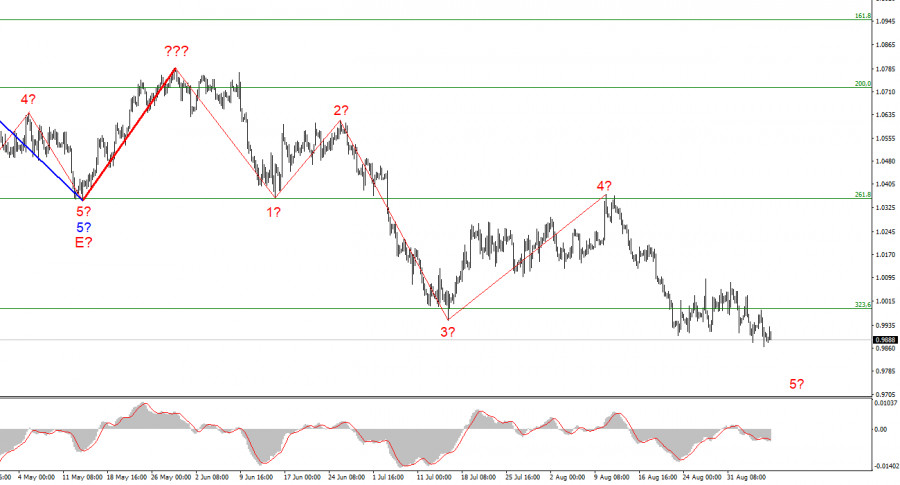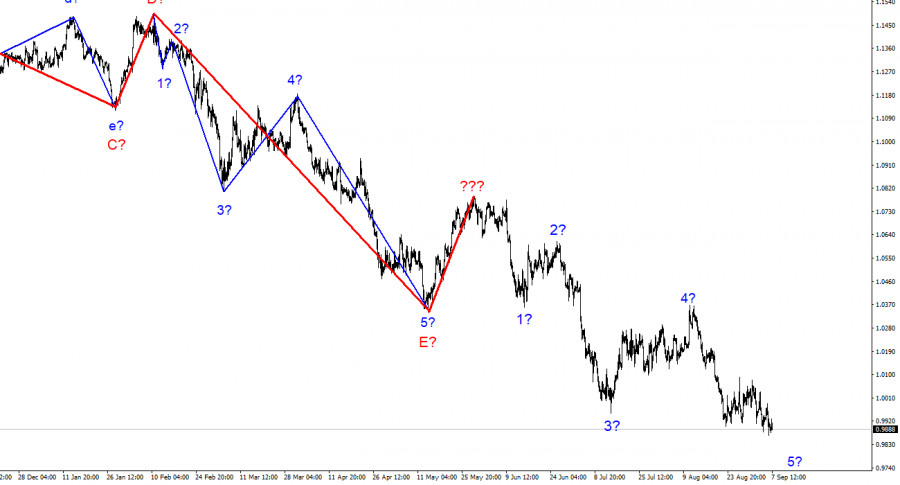

The wave marking of the 4-hour chart for the euro/dollar instrument still does not require adjustments, although wave 4 turned out to be longer than I expected, and now the construction of wave 5 is also delayed. The whole wave structure can become more complicated once again, but any structure can always take a more complex and extended form. There are no grounds to assume the completion of the downward trend segment yet. A successful attempt to break through the 0.9989 mark, which corresponds to 323.6% Fibonacci, indicates the market's readiness to continue reducing demand for the euro. I expect the decline in the quotes of the instrument will continue with the targets located below the 1.0000 mark within wave 5. Wave 5 can take almost any length since wave 4 turned out to be much longer than wave 2 – the waves acquire a more extended form as the downward trend section is built. Nevertheless, I note that the low of wave 5 is below the low of wave 3, so this wave can complete its construction at any time. And with it, the entire downward section of the trend.
The markets are not interested in the growing GDP in the Eurozone
The euro/dollar instrument fell by 30 basis points on Tuesday and another 40 on Wednesday. This week's amplitude of the instrument's movements remains rather weak, although the news background began to strengthen on Wednesday. Remember that the market could only pay attention to the ISM index in the US services sector on the first two days of the week. There were other business activity indices, but the ISM index is considered the most important and strongest among them. Nevertheless, I did not see any market reaction to this index, although the indicator increased compared to the previous month. The demand for the US currency continues to increase at the moment, but it is doing it very slowly, and we are already used to strong falls in the instrument.
Today, the final value of GDP in the second quarter was released in the European Union. Although the markets expected economic growth of 0.6% q/q, the real value was 0.8%. I think this report can be considered positive for the euro and the EU economy, which is increasingly predicted to have a difficult cold winter and a prolonged recession. As we can see, everything is fine with the economy now, and it is not only growing, but the growth rate is increasing from quarter to quarter. However, the market was not interested in this report. The European Central Bank's meeting results will be announced on Thursday. The interest rate should rise by at least 50 basis points, but this factor does not force the market to buy euros. Thus, it is very difficult for me to say what can now favorably affect the exchange rate of the European currency. If any, we will have to wait for reports on avoiding a recession or overcoming the gas crisis. If not, the euro may continue to decline.

General conclusions
Based on the analysis, I conclude that the construction of the downward trend section continues. I advise you to sell the instrument with targets near the estimated 0.9397 mark, equivalent to 423.6% Fibonacci, for each MACD signal "down" in the expectation of building a wave.5 So far, I don't see a single signal indicating this wave's end.
At the higher wave scale, the wave marking of the descending trend segment becomes noticeably more complicated and lengthens. It can take on almost any length, so I think it's best to isolate three and five-wave standard structures from the overall picture and work on them.